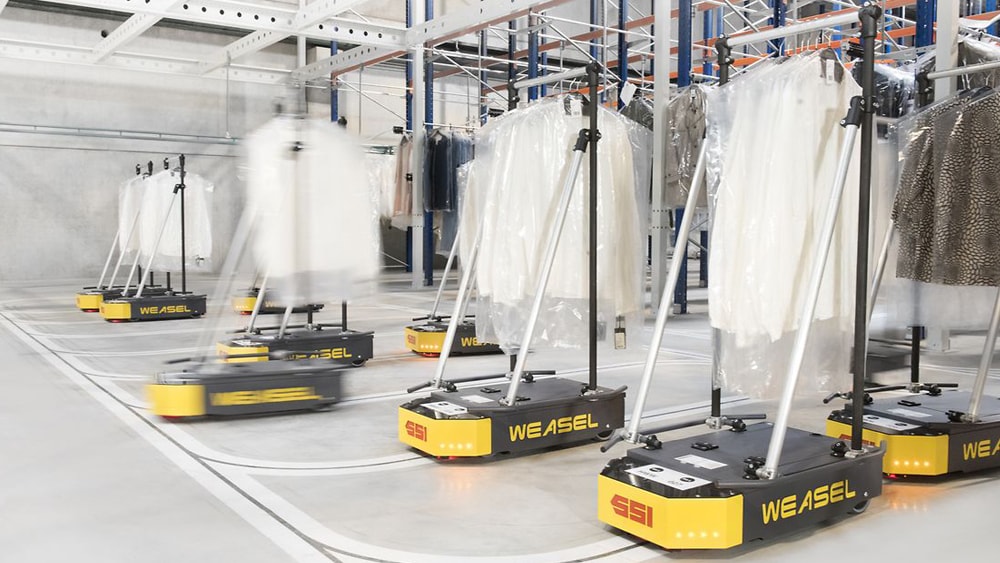Maintaining an adequate amount of inventory is a critical part of any supply chain to ensure that the products are made available in the stores at all times. The warehouses use appropriate tools or equipment to pick and place goods, that is, moving products from point A to point B. Nandika Puri, a Student of Masters of Fashion Technology, NIFT Delhi with guidance from Dr. Prabir Jana, NIFT Delhi talks about various equipment for warehousing pick & place operations.
Picking and placing action in a warehouse involves labour and management. The right product needs to be at the right place in order to cater to customer needs. Proper placing of goods lead to faster work and no time is wasted in finding the products.
In a traditional warehouse, the goods are picked up by a worker manually and are placed on a trolley. The operator pushes the trolley to respective places and manual palletization is done. This kind of storage and retrieval system is unable to provide a standardised layout as well as discipline of the warehouse. Not only the standardisation but manual picking of heavy products is also ergonomically challenging for the operator and can be hazardous to health. For this type if warehousing model, the space utilization cannot be done effectively and there is involved a high cost of man power and its maintenance.
The trolleys are the only critical movers in the entire process and are available in two different configurations. First is the warehouse (or platform) trolley which has 4 wheels (nylon/polyurethane) with double ball bearings and swivel motion. It comes with capacity options of 1000 kg, 500 kg, and 200 kg.
While the other is a hand operated trolley with the capability to lift loads from 5 cm to 20 cm. It has 4 smooth, swivel-motion wheels made of nylon/ polyurethane having a turning radius of less than 0.5 m. It has capacity options of 2000 kg and 500 kg. Both these trolleys are made of mild steel having dimensions of 0.5 X 0.5 X 1 m.
To further the ease of operations and fasten up the storage and retrieval processes, forklift machines are used. These machines are usually driver operated and are either run by batteries or use fuel as a power source. These semi-automatic devices can lift loads that are thousands of pounds, often several stories into the air, all without tipping over.
Forklift with a driver
The benefit of working with these machines is reduced manpower but more efficient results. These machines are easier to maintain and provide a greater safety to the workers though may require skill training.
Types of forklift machines and its features
| S. no. | Model | Features |
| 1. | Toyota 3 Wheel electric forklift | 3,000-4,000 lb. Lifting Capacity |
| Turn Speed control System | ||
| Wet Disc Brakes | ||
| 2. | Toyota Electric Reach Truck | 2,500 – 4,500 lbs. Lifting Capacity |
| Single Reach Model | ||
| 3. | KOMATSU FR50 Series | Capacity: 3,000lbs / 3,500lbs / 4,500lbs |
| Narrow Aisle | Truck Type: Single Reach / Double Reach | |
| Power Type: 36V Battery |
Today, the modern warehouses use fully automatic transport systems called as Automated Guided Vehicles (AGVs). The best point is that these machines are computer operated and thus require, no human intervention. They are widely used in warehousing operations as well as logistics, production, and other automotive industries. First AGV for industrial applications was invented by Barrett Electronics Corporation in 1954. This technology works or moves unmanned by following the magnets, lasers or wires on the floor.
AGVs ensure a better utilisation of the warehouse as they have a precise track to travel. Some are electronically charged while some work with the help of a chargeable battery. A much smarter version of AGVs automatically reach to the charging point when required. The best part of using an AGV is that the pick and place operation in warehouse can be safely operated without causing any harm to the employees’ health.
Types of AGVs and its features
| S.no. | Company /Model | Purpose | Feature |
| 1 | JBT CB 750 | Flexible to service racking, conveyors, stands, block stacking, etc. |
Drive: Electric |
| Control: Automatic Laser | |||
| Guided | |||
| Lift Capacity: 750 Kg | |||
| Elevated Height up to 6 m | |||
| Lift Speed: 4”/ Sec. | |||
| 2 | Toyota Tug-Cart | Tug-Cart mouse AGV | Capacity: 2,000-3,000 lb. |
| Load 24-Volt Electric | |||
| 3 | AGV Solutions A6 | Forklift: Pick and place | Max load: 1000kg |
| Max lifting height: 3000mm |
ROI Calculation
For calculating the ROI, we assume the indirect labour for AGV. We consider one engineer’s salary to be Rs. 30,000 per month and 100 operators required to work for 120 hand trolleys. Depreciation value is assumed to be 15 per cent. The calculation below is for a warehouse for the same area and same number of pick and drop operations per operator in a day.
The calculation does not consider trolleys, as it is a total labour relied tool and no automation or technology is involved.
| Total tasks | 1000 |
| Put away | 393 |
| Replenishment | 319 |
| Pick tasks | 38 |
| Put to door | 250 |
| Pick and Drop Activities | 431 |
| Parameters | Forklift machines | Automated Guided Vehicles (AGV) |
| Warehouse area (sq. ft.) | 156000.00 | 156000.00 |
| Equipment required | 5.00 | 1.00 |
| Picks and Drops per day per Person | 431.00 | 431.00 |
| Working days /month | 26.00 | 26.00 |
| No. of months /year | 12.00 | 12.00 |
| No of operator required | 15.00 | 0.00 |
| Cost of one machine (₹) | 550000.00 | 750000.00 |
| Cost of total machine (₹),T | 2750000.00 | 750000.00 |
| Annual Depreciation (%) | 0.15 | 0.15 |
| Depreciated value of m/c after one year (Z) | 2391304.35 | 652173.91 |
| Direct labour (one operator) | 9000.00 | 0.00 |
| Indirect labour (supervisor 3)/ Eng. Dept.(1)) | 45000.00 | 30000.00 |
| Total operators salary (per day) | 333.33 | 1000.00 |
| Total operators salary (Monthly) | 180000.00 | 30000.00 |
| Total operators salary (Yearly) | 2160000.00 | 360000.00 |
| Price of one pick and drop per day | 1.29 | 0.43 |
| Price of pick and drop yearly | 2608084.44 | 134.47 |
| Cash Inflow (I) | 448084.44 | 360000.00 |
| ROI for the first year, (X-Y)/Z | 0.19 | 0.55 |
| Payback Period (T/I) | 6.14 | 2.08 |
The calculation herby shows that even though an AGV is an expensive investment, it provides a good Return on Investment. The benefits to the organization include reduced labour, hence reduced human welfare activities and a safer way of storage and retrieval.











